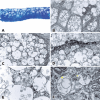Evidence of autophagic vesicles in a patient with Lisch corneal dystrophy
- PMID: 32159595
- PMCID: PMC11826730
- DOI: 10.5935/0004-2749.20200027
Evidence of autophagic vesicles in a patient with Lisch corneal dystrophy
Abstract
Lisch corneal dystrophy is a rare corneal disease characterized by the distinctive feature of highly vacuolated cells. Although this feature is important, the nature of these vacuoles within corneal cells remains unknown. Here, we sought to analyze corneal cells from a patient diagnosed with Lisch dystrophy to characterize the vacuoles within these cells. Analyses using histopathology examination, confocal microscopy, and transmission electron microscopy were all consistent with previous descriptions of Lisch cells. Importantly, the vacuoles within these cells appeared to be autophagosomes and autolysosomes, and could be stained with an anti-microtubule-associated protein 1A/1B-light chain 3 (LC3) antibody. Taken together, these findings indicate that the vacuoles we observed within superficial corneal cells of a patient with Lisch corneal dystrophy constituted autophagosomes and autolysosomes; this finding has not been previously reported and suggests a need for further analyses to define the role of autophagy in this ocular disease.
A distrofia corneana de Lisch é uma doença rara, caracterizada principalmente pela presença de células altamente vacuoladas. Embora esta característica seja importante, a natureza desses vacúolos dentro das células da córnea permanece des conhecida. Aqui, procuramos analisar as células da córnea de um paciente diagnosticado com distrofia de Lisch para caracterizar os vacúolos dentro dessas células. Análises utilizando exame histopatológico, microscopia confocal e microscopia eletrônica de transmissão foram todas consistentes com descrições previas de células de Lisch. Importante, os vacúolos dentro dessas células pareciam ser autofagossomos e autolisossomos, e poderiam ser corados com um anticorpo proteico 1A/1B-cadeia leve 3 (LC3) da proteína anti-microtúbulo associado a microtúbulos. Em conjunto, esses achados indicam que os vacúolos observados nas células superficiais da córnea de um paciente com distrofia corneana de Lisch constituíram autofagossomos e autolisossomos. Esse achado não foi relatado anteriormente e sugere a necessidade de mais análises para definir o papel da autofagia nessa doença ocular.
Conflict of interest statement
Figures


Similar articles
-
A corneal tulip? Assessing corneal opacities in Lisch corneal epithelial dystrophy.Clin Exp Optom. 2018 Jul;101(4):596-598. doi: 10.1111/cxo.12555. Epub 2017 May 25. Clin Exp Optom. 2018. PMID: 28545158 No abstract available.
-
In vivo confocal microscopy and spectral domain anterior segment OCT in Lisch epithelial corneal dystrophy.J Fr Ophtalmol. 2015 Sep;38(7):e151-3. doi: 10.1016/j.jfo.2014.07.017. Epub 2015 Jul 3. J Fr Ophtalmol. 2015. PMID: 26144589 No abstract available.
-
[In vitro histological analysis, in vivo confocal microscopy and anterior segment spectral domain OCT in a case of Lisch epithelial corneal dystrophy].J Fr Ophtalmol. 2019 Oct;42(8):e363-e366. doi: 10.1016/j.jfo.2019.04.010. Epub 2019 Jun 13. J Fr Ophtalmol. 2019. PMID: 31202779 French. No abstract available.
-
[The different opacity patterns of Lisch corneal dystrophy].Klin Monbl Augenheilkd. 2006 Oct;223(10):837-40. doi: 10.1055/s-2006-927120. Klin Monbl Augenheilkd. 2006. PMID: 17063428 Review. German.
-
Recurrent Lisch Epithelial Corneal Dystrophy Treated With 5-Fluorouracil: A Case Report and Review of the Literature.Cornea. 2023 May 1;42(5):645-647. doi: 10.1097/ICO.0000000000003211. Epub 2022 Dec 19. Cornea. 2023. PMID: 36533990 Free PMC article. Review.
References
-
- Oliver VF, Vincent AL. The genetics and pathophysiology of IC3D category 1 corneal dystrophies: a review. Asia Pac J Ophthalmol (Phila) 2016;5(4):272–281. - PubMed
-
- Weiss JS, Møller HU, Aldave AJ, Seitz B, Bredrup C, Kivelä T, et al. IC3D classification of corneal dystrophies-edition 2. Cornea. 2015;34(2):117–159. - PubMed
-
- Lisch W, Büttner A, Oeffner F, Böddeker I, Engel H, Lisch C, et al. Lisch corneal dystrophy is genetically distinct from Meesmann corneal dystrophy and maps to xp22.3. Am J Ophthalmol. 2000;130(4):461–468. - PubMed
-
- Lisch W, Steuhl KP, Lisch C, Weidle EG, Emmig CT, Cohen KL, et al. A new, band-shaped and whorled microcystic dystrophy of the corneal epithelium. Am J Ophthalmol. 1992;114(1):35–44. - PubMed
Publication types
MeSH terms
Supplementary concepts
LinkOut - more resources
Full Text Sources

